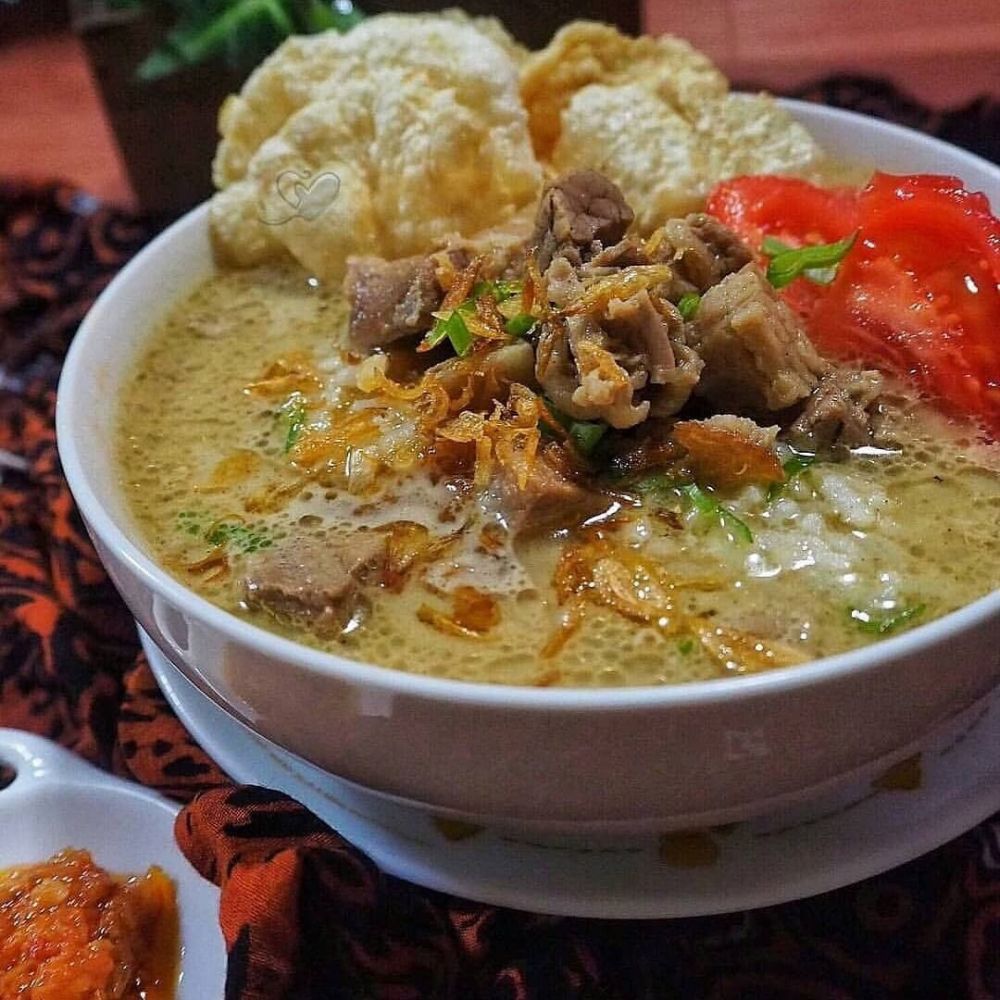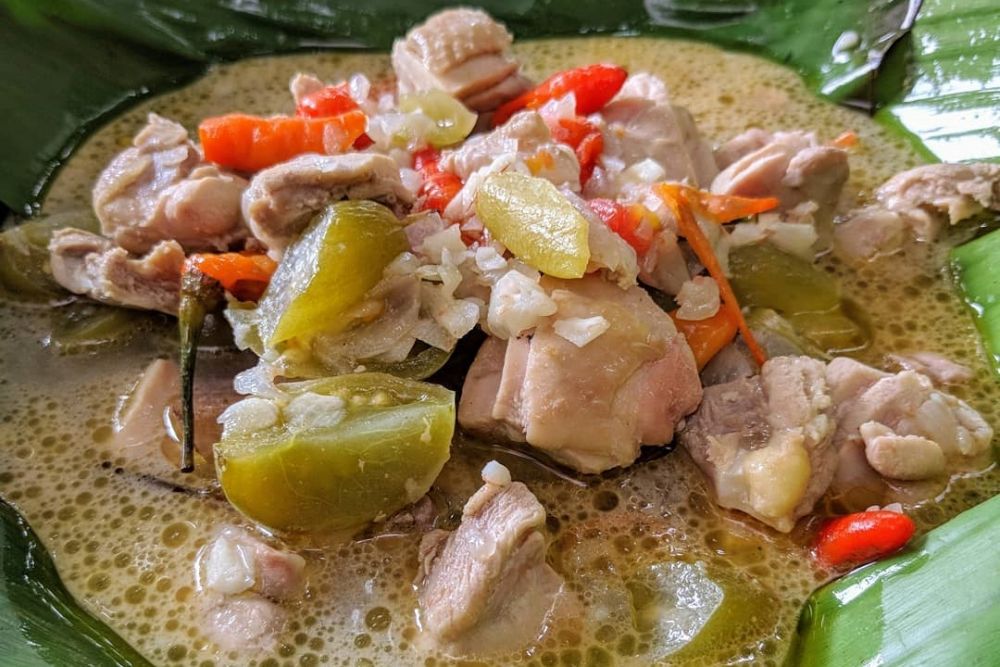
Of course. Here is a 1,200-word article about Garang Asem.
Garang Asem: The Steamed, Sour, and Spicy Soul of Java
In the vast and flavorful tapestry of Indonesian cuisine, some dishes shout with the fiery intensity of a volcano, while others whisper with the subtlety of a morning mist. Garang Asem, a remarkable dish from the heart of Central Java, manages to do both. It arrives not in a grand bowl, but humbly wrapped in a banana leaf parcel. Yet, to untie its string and unfold the softened, green leaf is to release a fragrant cloud of steam that carries a promise—a promise of sour, spicy, savory, and utterly soul-soothing perfection.
Garang Asem is more than just a meal; it is a culinary artifact, a testament to the Javanese philosophy of flavor balance, and a ritual that connects the diner to the very soil and traditions of the land. Its name, a direct and potent descriptor, translates from Javanese to "Fierce Sour." "Garang" means fierce, intense, or even ferocious, alluding to the potent heat from chilies. "Asem" simply means sour. Together, they perfectly encapsulate the dish’s bold and invigorating character, a wake-up call for the palate that is as refreshing as it is complex.

A Journey to the Heartlands: Origins and Meaning
The story of Garang Asem begins in the northern coastal plains and inland agricultural heartlands of Central Java, specifically in areas like Kudus, Demak, Pati, and Grobogan. This region, known for its rich history and deep-rooted traditions, is the cradle of this unique dish. Unlike many royal court cuisines, Garang Asem feels more rustic, more of the people. It’s the kind of special-occasion food served at weddings, community feasts (hajatan), and celebratory gatherings, a dish that brings people together.
Its preparation method speaks volumes about its origins. The use of banana leaves (daun pisang) as a cooking vessel is an ancient technique found across Southeast Asia. Before the advent of modern cookware, nature provided the perfect tools. The banana leaf is not merely a wrapper; it is an active ingredient. As the parcel steams, the leaf imparts a subtle, earthy, and slightly sweet aroma that infuses the chicken and broth within. It also creates a personal, self-contained cooking environment, trapping moisture and concentrating the flavors, ensuring the chicken becomes impossibly tender while stewing in its own magnificent juices. This eco-friendly, time-honored method is central to the identity of Garang Asem.
The Anatomy of a Flavor Bomb: Deconstructing the Ingredients
The genius of Garang Asem lies in its symphony of relatively simple, yet powerful, ingredients. Each component plays a crucial and distinct role in achieving the dish’s signature taste profile.
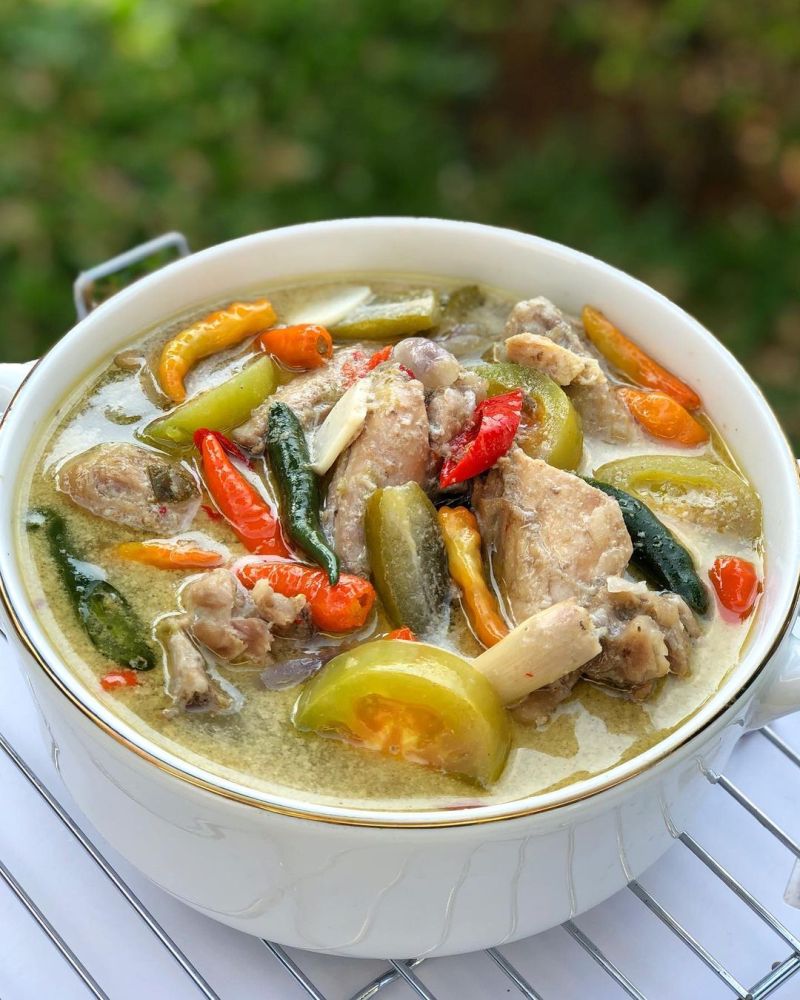
At its core is the chicken. Traditionally, the preferred choice is ayam kampung, or free-range village chicken. These birds, leaner and more muscular than their commercially farmed counterparts, have a firmer texture and a much deeper, more pronounced chicken flavor. This robustness is essential, as the meat needs to hold its own against the assertive sour and spicy notes without falling apart during the lengthy steaming process. The chicken is typically cut into smaller, bone-in pieces, as the bones contribute invaluable depth and collagen to the resulting broth.
The "Asem" (sour) element is what truly defines the dish. The star ingredient for this is belimbing wuluh, also known as tree cucumber or bilimbi. This small, green, ribbed fruit, a close relative of the starfruit, is intensely tart. When sliced and steamed, it softens into a pulpy texture, releasing its bright, clean sourness into the broth. It provides a zesty punch that cuts through the richness of the chicken and, if used, the coconut milk. In areas where belimbing wuluh is not readily available, tamarind paste (asam jawa) or even green tomatoes are used as worthy substitutes, each lending its own unique sour character.
The "Garang" (fierce) kick comes from a generous helping of chilies. Whole bird’s eye chilies (cabe rawit merah) are scattered throughout the parcel. This is a brilliant, interactive element of the dish. Left whole, they infuse the broth with a gentle, fragrant heat. For those who crave a more explosive experience, the chilies can be crushed with a spoon directly in their bowl, releasing their full fiery potential. The diner is thus in complete control of their own heat level.
Building the savory foundation are the quintessential Indonesian aromatics. Sliced shallots and garlic provide a sweet, pungent base. Lemongrass (serai) is bruised to release its citrusy fragrance, while galangal (lengkuas) adds a sharp, peppery, and slightly pine-like note. A few leaves of daun salam, the Indonesian bay leaf, contribute a subtle, earthy aroma that is unique to the archipelago’s cuisine.
Finally, there is the liquid. Here, Garang Asem splits into two main schools of thought. The first, and perhaps more traditional version, is Garang Asem Bening (clear). This style uses only water or a light chicken broth, resulting in a light, incredibly refreshing, and translucent soup that allows the sour and spicy notes to shine brightly. The second version, popular in places like Kudus, incorporates thin coconut milk (santan encer). This adds a layer of creamy richness that mellows the acidity and spice, creating a broth that is more rounded and comforting, yet still unmistakably Garang Asem.
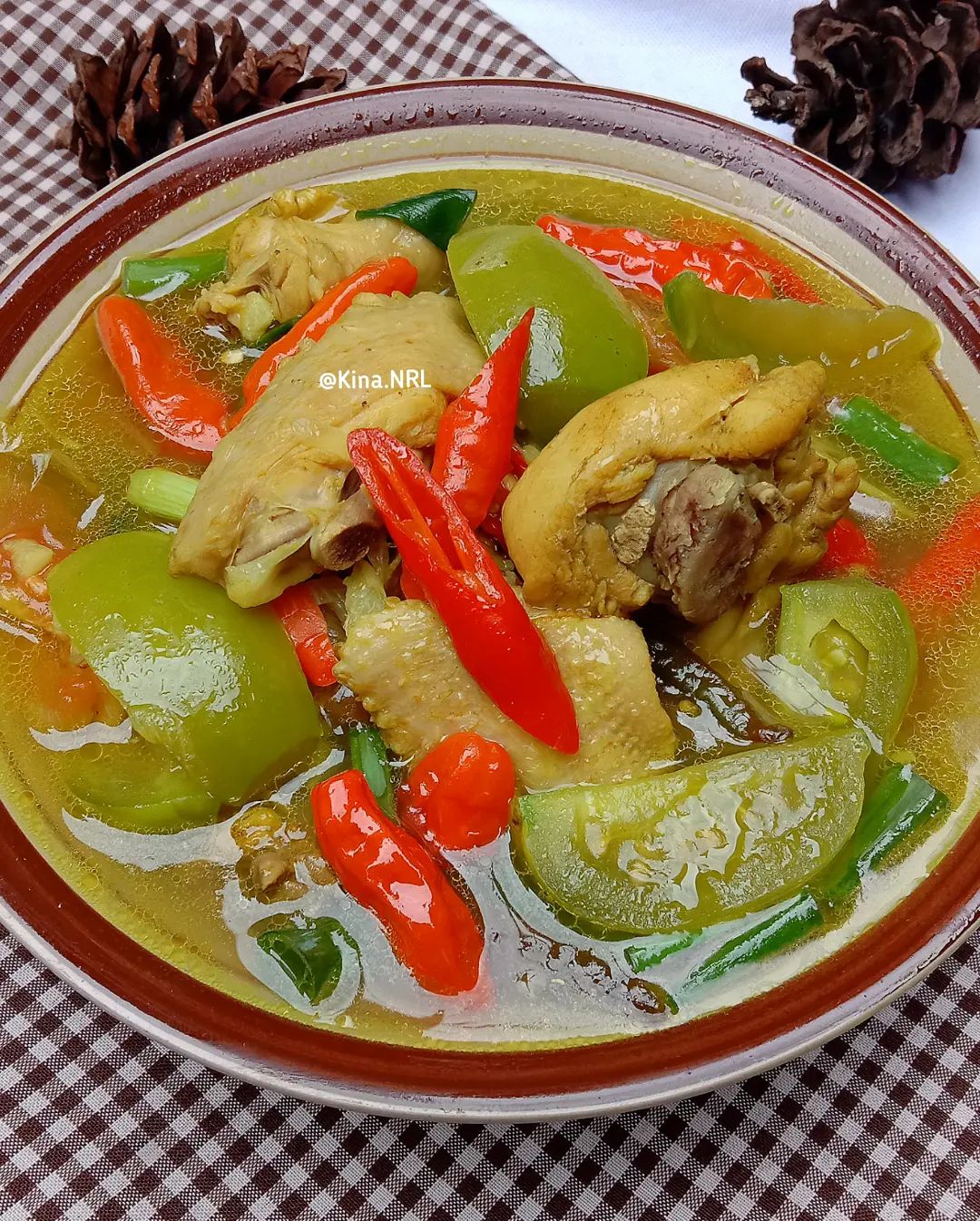
The Ritual of Preparation: A Symphony in a Leaf
Making Garang Asem is a process of careful assembly, a ritual of layering flavors. First, the banana leaves are briefly wilted over an open flame or with hot water to make them pliable. Two layers are often used for strength.
Inside the leaf, the construction begins. A bed of sliced aromatics—shallots, garlic, galangal, lemongrass, and daun salam—is laid down. The chicken pieces, sometimes lightly marinated in salt and lime juice, are placed on top. Then come the stars of the show: slices of belimbing wuluh and whole bird’s eye chilies are generously scattered over and around the chicken. A pinch of salt and sugar is added to balance the flavors. Finally, the broth or coconut milk is poured in before the leaf is folded meticulously into a secure parcel, known as a tum or pincuk, and fastened with a small bamboo skewer or string.
These parcels are then placed in a steamer and cooked for at least an hour, sometimes longer. Inside this steamy chamber, magic happens. The chicken slowly renders its fat and flavor. The belimbing wuluh breaks down, infusing the liquid with its signature tang. The chilies and spices release their potent essences. All these individual notes meld, harmonize, and transform into a single, cohesive, and breathtakingly delicious broth.
The Experience: Unwrapping a Gift of Flavor
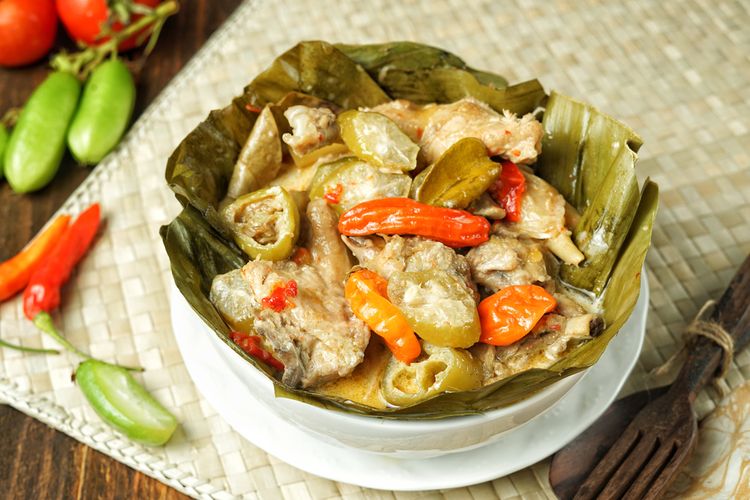
Garang Asem is almost always served piping hot, straight from the steamer, with a plate of fluffy steamed rice. The experience begins with the unwrapping. As you open the parcel, a billow of fragrant steam escapes, a complex perfume of tangy fruit, spicy chili, savory chicken, and the unmistakable scent of cooked banana leaf.
The first spoonful is a revelation. The broth hits you first—a bright, sharp sourness that immediately awakens your senses, followed by the creeping, warming heat of the chili, all underpinned by the deep, savory flavor of the chicken. The chicken itself, having been steamed to perfection, is fall-off-the-bone tender. The softened slices of belimbing wuluh and the whole chilies are treasures to be found and savored. Eaten with rice, which soaks up the incredible broth, it is a complete and deeply satisfying meal. It is simultaneously comfort food and a jolt of energy, perfect for a hot, humid day when its refreshing qualities can be fully appreciated.
Today, while the classic recipe remains sacred, chefs and home cooks may offer slight variations. Some might use duck or even fish, while restaurants in cities like Jakarta or Bali might present a deconstructed version. But the soul of the dish—the holy trinity of tender chicken, fierce spice, and assertive sourness, all lovingly encased in a banana leaf—remains the true measure of a great Garang Asem. It is a dish that tells a story, a taste of the Javanese spirit: humble in appearance, but intense, complex, and unforgettable in character. To experience Garang Asem is to taste the very heart of Java.


Garang Asem: The Steamed, Sour, and Spicy Soul of Java pictures collections gallery
Garang Asem: The Steamed, Sour, and Spicy Soul of Java is a nice pictures and stock photo for your computer desktop or your smartphone device (ipad, tablet, blackberry, iphone, and other device) and also for your personal use. Free available for desktop wallpaper or additional image collections for your all needs. And was uploaded by admit at date July 1, 2025. You can download it in your computer by clicking download button to save image... have nice day and have fun guys..
This 1 image in featured post from 0 Photos/images Gallery and awesome picture selections about Garang Asem: The Steamed, Sour, and Spicy Soul of Java is available to download. "Download & Save" images/pictures/wallpapers now and this Is one of the post that listed in packed to Category is Foods directory, with image dimension/resolution size is 1000 × 667 px and size image/picture file is 125 KB with original link post ID is : https://powae.pw/of-course-here-is-a-1200-word-article-about-garang-asem/. Get download/save images in post and gallery, "download" images or "preview" it on a bigger image for spesification sample in Large size (full attachment size) here : [Download & View to Large size]. Just Simple way, in thumbnail or in Gallery. *Click images to view Large Size.We collect this wonderful image from online and choose one of the best for you. Pictures collection that posted here was carefully chosen and published by author after choosing the ones which are best among the others. So, ultimately we make it and here these list of best image for your inspiration and informational reason regarding the Garang Asem: The Steamed, Sour, and Spicy Soul of Java as part of blogsite exclusive updates collection. So, take your time and find the best informations and pictures posted here that suitable with your needs and use it for your own collection and personal use. About Image information: Image has been submitted and You are able to give your opinion as evaluations to our web site value.
Don't forget to comment if you interest with this images, you can share this post to social media like as facebook, twitter, google+, pinterest, stumbleupon, and more. just click social media buttons for share this post Garang Asem: The Steamed, Sour, and Spicy Soul of Java Now. :)
Thanks for your visit, I hope you happy come to opo wae, wis opo wae, and get what you're looking for. And hope sometimes you will come back again here. All you need to do is help us develop by discussing this Garang Asem: The Steamed, Sour, and Spicy Soul of Java if you like it "leave your comment". have fun, Thank you.



